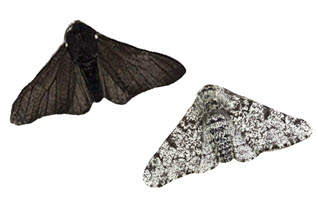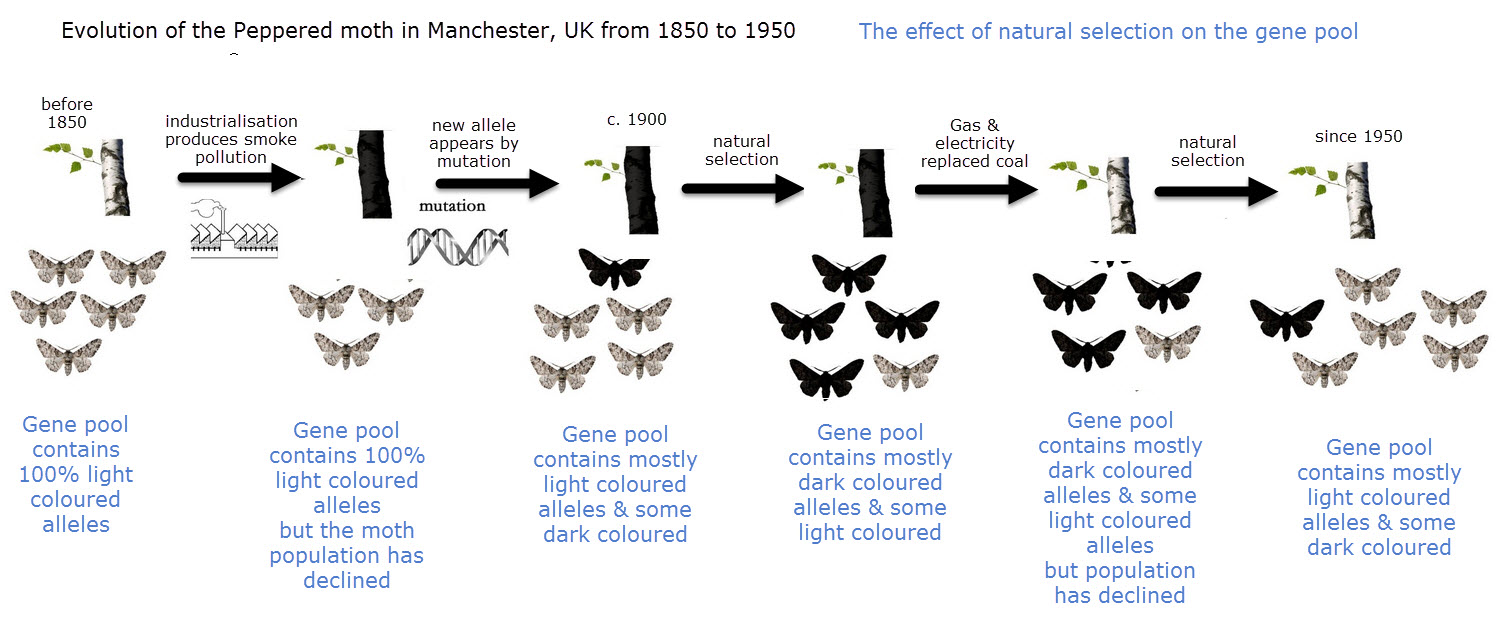Gene pools
 Speciation and how natural selection changes gene pools
Speciation and how natural selection changes gene pools
After consideration of what a gene pool is and the way that evolution causes changes in gene pools this lesson looks at the driving forces of speciation using the examples of Bird of paradise species an excellent video illustrates these concepts and there are some questions for students to go with the video.
Lesson Description
Guiding Questions
What is a gene pool?
How does the concept of gene pools help us to understand natural selection?
How can natural selection lead to the creation of new species?
Activity 1 Introduction to gene pools
The following example of the peppered moth (Biston betularia) and its two forms, light (morpha typica) and dark (morpha carbonaria) is well known. You may have covered it in topic 5.1 or 5.2 in the Evolution topic.
Look at the timeline diagram below then answer the question which follow.
Click image to open it in a new browser window.
A gene pool
The set of all alleles of genes in a population which is interbreeding.
The sum of a population's genetic material.
A pool of genes because any member of the population had a chance of getting any of the alleles.
Like a car pool - where anyone can use any of the cars.
Questions
Using the timeline above write answers to the questions below.
- What is the characteristic which helps the moths survival in 1850? (1)
- It is thought that the light form of the peppered moth is caused by recessive alleles of a single gene. The dark form allele is thought to be dominant. What will the genotypes of the light and dark forms be? (2)
- If 20% of the peppered moths were the dark form in 1900, how many dark form alleles would be in the population? Give an estimate and a range of possible values. (2)
- If predators of the peppered moth ate mostly the light form in Manchester in the early 20th century how would this affect the percentage of light form alleles? Explain why. (2)
- What effect would the predation on light forms have on the percentage of dark form alleles in the population. Explain why. (2)
- Describe the effect of selective predation, (or natural selection or even evolution) on the allele frequencies in a gene pool. (3)
(Total 12 marks)
Click the eye icon for some model answers.
- the moths are camouflaged against tree bark so predators cannot find them.
- If d=allele for light form, and D=allele for dark form
then the genotypes are dd = light form, Dd or DD = dark form. - The maximum would be 20% if all the dark form had the DD genotype.
The minimum would be 10% if all the dark form had Dd genotype.
It is likely that more Dd genotypes will be present than DD so overall perhaps 12% of alleles would be D alleles. - For each light form eaten there are two d alleles lost from the gene pool.
therefore the % of light form alleles would go down. - If there are fewer light form alleles, and the dark form allele number remains the same, then the % of dark form alleles will increase. 12 out of 100 alleles (12%) might change to 12 out of 80 alleles. (15%)
- Selective predation will decrease the % of one allele more than another.
In fact, if the % of one allele decreases then the % of the other allele will increase
This will cause a change in the composition of alleles in a gene pool.
Natural selection will do the same if some genetically controlled characteristics are better adapted.
Evolution is the gradual change in characteristics over time, and so this will also change the allele frequencies.
Activity 2: The driving forces of speciation - reproductive isolation and divergence.
Watch the video below about methods of speciation in bird of paradise species.
Answer the questions on the worksheet ![]() Speciation - an illustrated introduction below.
Speciation - an illustrated introduction below.
..
Teachers notes
The first activity follows from work covered in the Evolution topic 5.1 and 5.2 and uses Peppered moth evolution to illustrate changes to gene pools.
The second activity uses a great video explaining how speciation occurs after isolation of two populations.
There are some model answers to the questions on the video here: Gene pool - model answers to video questions
For another good example of how biologists study speciation see this video explanation of colour change in rock pocked mouse in new mexico. (HHMI)
**************************************************************************************************************************************************
I have an idea for a third activity in this lesson ... for this topic
Activity 3: Data activity to identify different types of isolation and different types of selection
I want to provide some real research data which student can analyse to illustrate the different types of selection.
I'm still looking for the data.

 IB Docs (2) Team
IB Docs (2) Team

